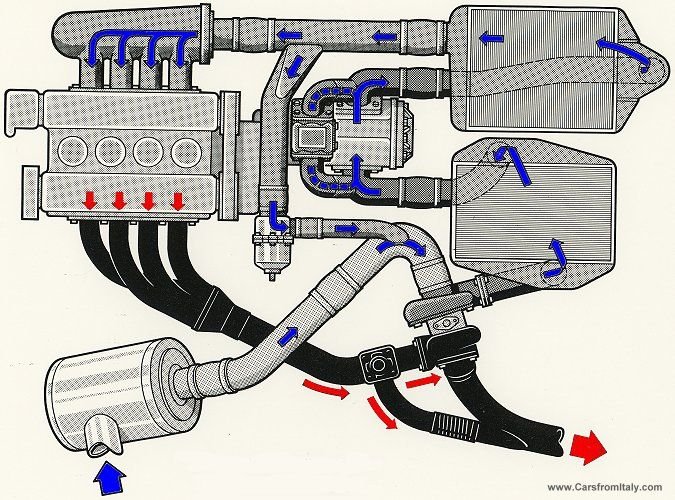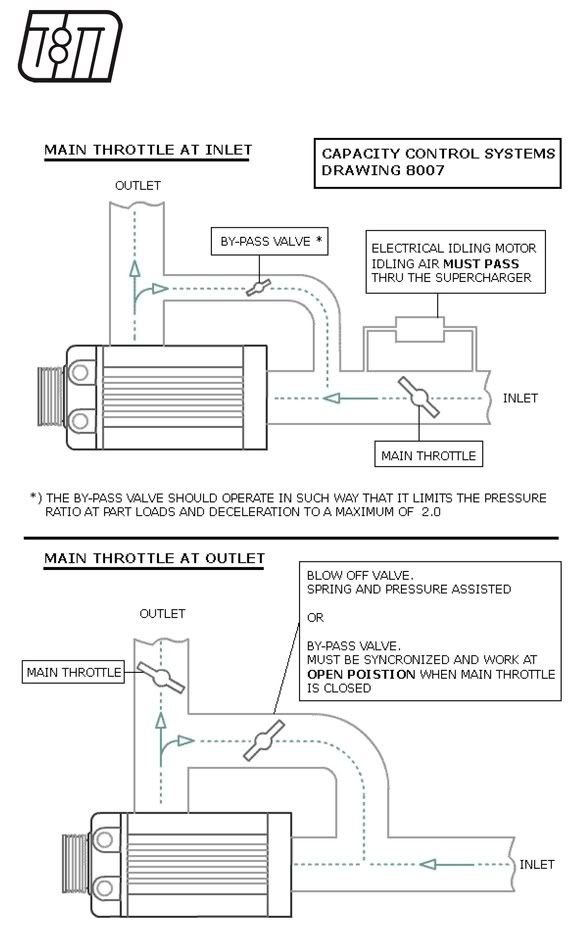Thomas I think either compounding (serial) or parallel operation could work fine depending on how you choose your hardware.
The compound method depends on good wastegate control, and a big turbine with a large A/R, but not necessarily a big compressor (if this is going to be a street setup). For someone who wants really stupid power at huge boost levels, then a big turbine AND a big compressor should be the ticket.
If you look at big stationary engines they have turbos with relatively small compressors that produce only a medium amount of boost (around 1 bar) at full load, but they have huge turbine sections so they won't introduce a lot of back pressure in the exhaust. Lag or spool time isn't really an issue because these engines (for generators) run at a fixed RPM, and are usually at least 50% loaded all the time. These turbos don't start making any boost until the engine hits 40-50% power.
So IMO, the best compound setup for the street would keep the ratios short in both stages to achieve whatever final ratio you wanted.
It would be really interesting to plumb the wastegate first for final stage pressure control, and then perhaps interstage pressure control (to limit the turbo only) to see which would work best.
I think the parallel setup as you described would work too, but it would require more plumbing and controls, and would require the SC to run inverted as Wayne said, so you'd have access to both the inlet and discharge.
Justen, with a 2 stage reciprocating gas compressor a common configuration is a 10" (diameter) first stage cylinder with an 8" second stage cylinder. Both have the same 6" or 7" stroke, but very different displacements due to the diameters, and the smaller displacement cylinder doesn't restrict the larger one, although the interstage pressure has to be monitored to be sure the ratio doesn't get too short or too long. One of the secrets to making these different capacity cylinders play well together are VE adjusting devices called variable volume clearance pockets. By adjusting these, it's possible to keep the each stage's compression ratio happy.
Likewise, for this compound application, I think if the sizing of the SC and turbo were done according to the parameters already set forth, and the interstage pressure ratio controlled by the wastegate, it should work fine.
I think either of these setups would be fascinating to setup and tune. I wish I could afford to build an engine test cell - these days I'd get a bigger kick out of testing the motors than driving the cars...
The compound method depends on good wastegate control, and a big turbine with a large A/R, but not necessarily a big compressor (if this is going to be a street setup). For someone who wants really stupid power at huge boost levels, then a big turbine AND a big compressor should be the ticket.
If you look at big stationary engines they have turbos with relatively small compressors that produce only a medium amount of boost (around 1 bar) at full load, but they have huge turbine sections so they won't introduce a lot of back pressure in the exhaust. Lag or spool time isn't really an issue because these engines (for generators) run at a fixed RPM, and are usually at least 50% loaded all the time. These turbos don't start making any boost until the engine hits 40-50% power.
So IMO, the best compound setup for the street would keep the ratios short in both stages to achieve whatever final ratio you wanted.
It would be really interesting to plumb the wastegate first for final stage pressure control, and then perhaps interstage pressure control (to limit the turbo only) to see which would work best.
I think the parallel setup as you described would work too, but it would require more plumbing and controls, and would require the SC to run inverted as Wayne said, so you'd have access to both the inlet and discharge.
Justen, with a 2 stage reciprocating gas compressor a common configuration is a 10" (diameter) first stage cylinder with an 8" second stage cylinder. Both have the same 6" or 7" stroke, but very different displacements due to the diameters, and the smaller displacement cylinder doesn't restrict the larger one, although the interstage pressure has to be monitored to be sure the ratio doesn't get too short or too long. One of the secrets to making these different capacity cylinders play well together are VE adjusting devices called variable volume clearance pockets. By adjusting these, it's possible to keep the each stage's compression ratio happy.
Likewise, for this compound application, I think if the sizing of the SC and turbo were done according to the parameters already set forth, and the interstage pressure ratio controlled by the wastegate, it should work fine.
I think either of these setups would be fascinating to setup and tune. I wish I could afford to build an engine test cell - these days I'd get a bigger kick out of testing the motors than driving the cars...


